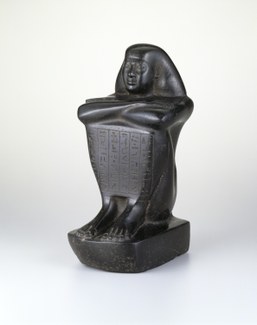Block Statue of Shebenhor

Block Statue of Shebenhor
Basalt; H. 28 cm; W. 13 cm; D. 16.2 cm
Egypt; XXVI Dynasty (664–525 BCE)
Gift of Mrs. George L. Otis; Art Institute of Chicago: 1924.754
© Courtesy of the Art Institute of Chicago
Statues of seated priests or dignitaries with their cloaks drawn over the feet and their arms crossed were a frequent Egyptian sculptural type since the Middle Kingdom (ca. 2000 BCE). Made for tombs or as intercessory statues for temples, they functioned as symbols of the deceased’s religious piety and his hope for rebirth. Their surfaces are usually covered in texts that glorify the owner’s life, or in auspicious formulas. The inscriptions on Shebenhor’s statue call upon the gods Osiris and Bastet to grant funerary offerings in memory of the deceased throughout Egypt.
Emily Teeter. Egyptian Art. Art Institute of Chicago Museum Studies, 20, no.1, 1994. 25-27, no.9